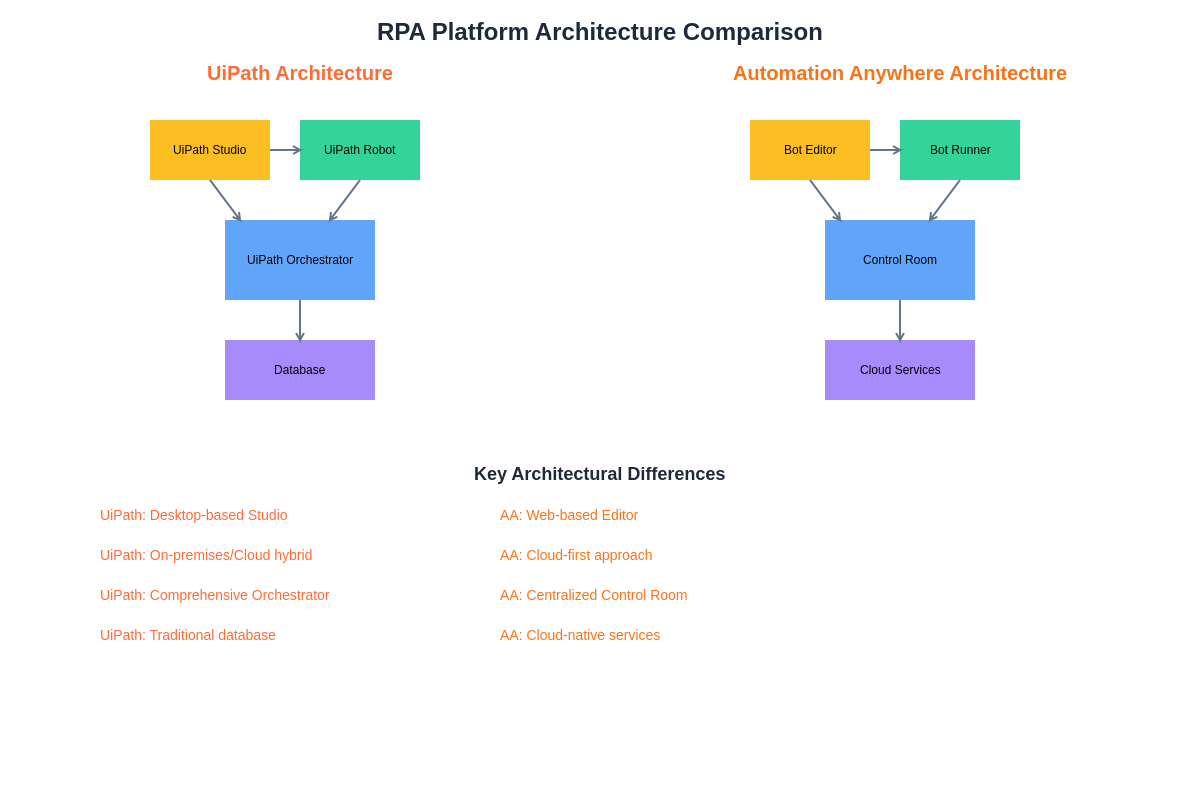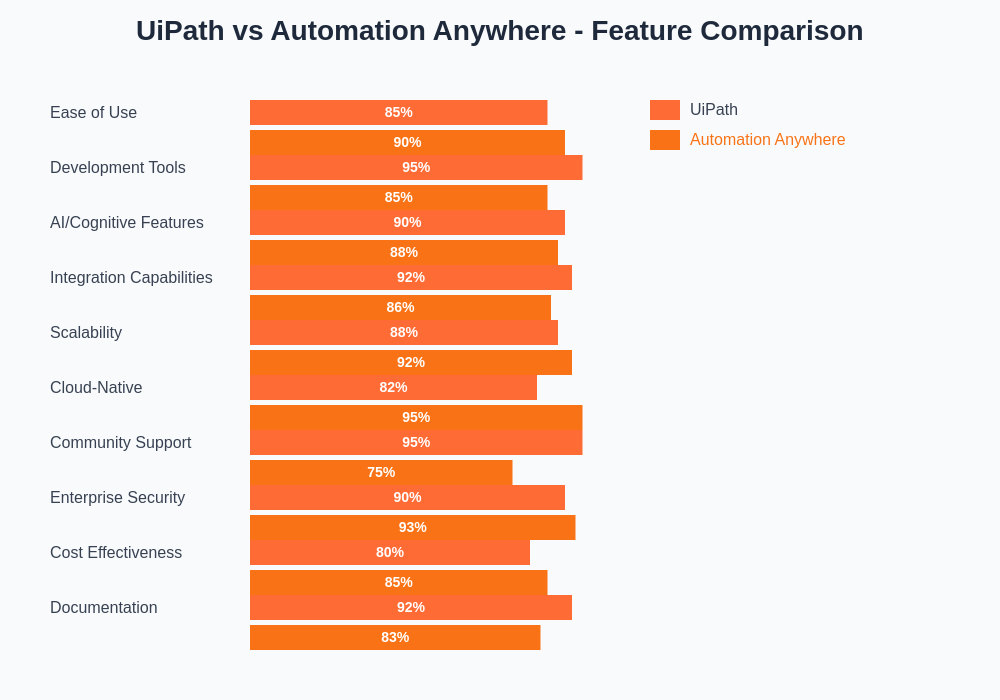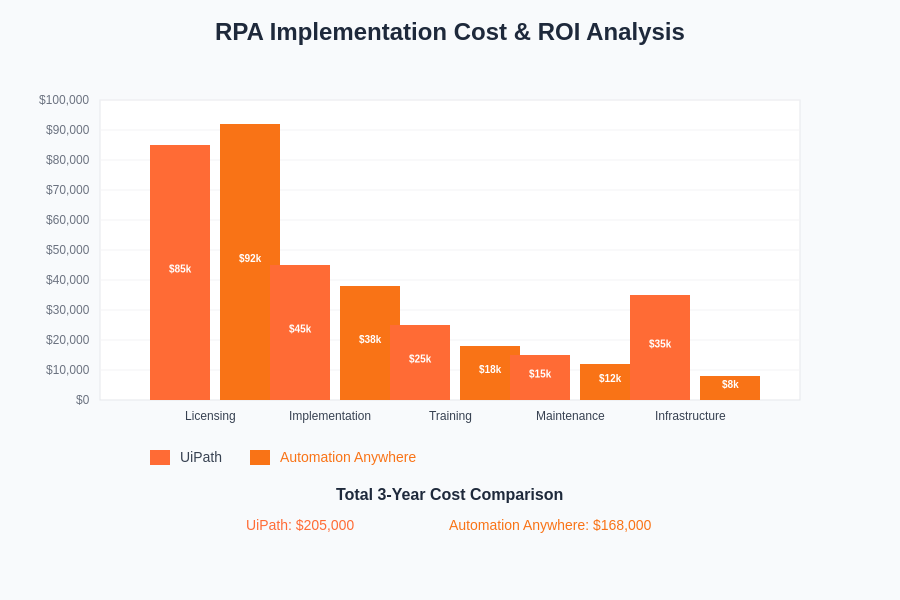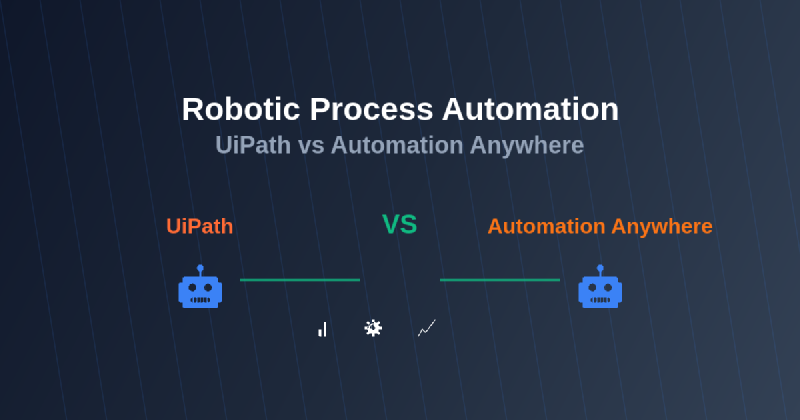The enterprise automation landscape has witnessed unprecedented transformation through Robotic Process Automation, with UiPath and Automation Anywhere emerging as the dominant forces shaping how organizations approach digital transformation. These sophisticated platforms have revolutionized business operations by enabling companies to automate repetitive tasks, streamline complex workflows, and achieve remarkable efficiency gains while reducing operational costs and human error rates across diverse industry sectors.
Explore the latest trends in automation technology to understand how RPA continues to evolve and integrate with cutting-edge artificial intelligence and machine learning capabilities. The competition between these industry leaders has driven rapid innovation, resulting in increasingly powerful automation solutions that cater to organizations of all sizes and complexity levels.
Understanding Robotic Process Automation Fundamentals
Robotic Process Automation represents a transformative technology paradigm that enables organizations to deploy software robots capable of mimicking human interactions with digital systems. These intelligent automation solutions can navigate applications, manipulate data, trigger responses, and communicate with other systems to execute business processes with unprecedented accuracy and consistency. The fundamental premise of RPA revolves around creating virtual workforces that operate alongside human employees, handling routine tasks while freeing up valuable human resources for strategic initiatives and creative problem-solving activities.
The evolution of RPA technology has progressed from simple screen scraping and basic task automation to sophisticated cognitive automation platforms capable of processing unstructured data, making intelligent decisions, and learning from historical patterns. Modern RPA solutions integrate seamlessly with existing enterprise systems without requiring extensive modifications to underlying infrastructure, making them attractive options for organizations seeking rapid digital transformation without substantial technology overhauls.
UiPath Platform Architecture and Capabilities
UiPath has established itself as a comprehensive automation platform that combines intuitive design tools with robust enterprise-grade capabilities. The platform’s architecture centers around three core components: UiPath Studio for development, UiPath Orchestrator for management and monitoring, and UiPath Robots for execution. This integrated approach enables organizations to design, deploy, and manage automation workflows across diverse environments while maintaining centralized control and visibility over their entire automation portfolio.
The UiPath ecosystem distinguishes itself through its low-code development environment that empowers both technical and business users to create sophisticated automation solutions. The platform’s drag-and-drop interface, combined with extensive pre-built activity libraries, enables rapid development of complex workflows without requiring deep programming expertise. UiPath’s computer vision capabilities and AI-powered document processing features have positioned it as a leader in intelligent automation, capable of handling both structured and unstructured data with remarkable accuracy.
UiPath’s cloud-native architecture facilitates seamless scalability and enables organizations to deploy automation solutions across hybrid environments. The platform’s integration capabilities span hundreds of enterprise applications, enabling comprehensive end-to-end process automation that transcends traditional system boundaries. Advanced analytics and reporting features provide detailed insights into automation performance, helping organizations optimize their digital workforce and identify additional automation opportunities.
Automation Anywhere Platform Architecture and Features
Automation Anywhere has evolved into a comprehensive intelligent automation platform that emphasizes cloud-first deployment and AI-driven capabilities. The platform’s architecture is built around the Automation Anywhere Control Room, which serves as the central hub for bot development, deployment, and management. This cloud-native approach enables organizations to quickly scale their automation initiatives while benefiting from continuous platform updates and enhanced security features.
Discover advanced automation solutions with Claude to enhance your understanding of how AI-powered platforms can transform business processes through intelligent automation strategies. The Automation Anywhere Bot Store provides access to thousands of pre-built automation solutions, enabling organizations to accelerate their automation journeys by leveraging proven workflows and industry-specific templates.
The platform’s unique approach to automation development incorporates natural language processing capabilities that allow users to describe processes in plain English, which the system then converts into executable automation workflows. This innovative feature democratizes automation development by enabling business users with limited technical expertise to contribute directly to automation initiatives. Automation Anywhere’s IQ Bot technology specializes in cognitive automation, capable of processing unstructured documents and extracting relevant information through advanced machine learning algorithms.
Automation Anywhere’s emphasis on security and governance includes comprehensive audit trails, role-based access controls, and encryption protocols that meet enterprise-grade requirements. The platform’s integration ecosystem supports connections with hundreds of business applications, cloud services, and legacy systems, enabling comprehensive automation solutions that span entire organizational technology stacks.
Development Environment and User Experience Comparison
The development experience represents a critical differentiator between UiPath and Automation Anywhere, with each platform offering distinct approaches to automation creation and management. UiPath Studio provides a comprehensive integrated development environment that combines visual workflow design with advanced debugging capabilities and version control integration. The platform’s intuitive interface enables developers to create complex automation solutions through drag-and-drop functionality while providing access to advanced scripting capabilities for power users.
UiPath’s approach to user experience emphasizes accessibility across different skill levels, with separate interfaces optimized for citizen developers and professional automation engineers. The platform’s extensive documentation, community resources, and learning materials have created a robust ecosystem that supports users throughout their automation journey. UiPath’s recorder functionality captures user interactions and automatically generates automation workflows, significantly reducing development time for routine process automation.
Automation Anywhere’s development environment prioritizes simplicity and ease of use through its web-based Bot Editor, which eliminates the need for desktop installations and enables collaborative development across distributed teams. The platform’s natural language interface represents a significant innovation in automation development, allowing users to describe processes in conversational language that the system interprets and converts into functional automation workflows.
The cloud-first architecture of Automation Anywhere enables seamless collaboration and version management, with all development activities occurring within the browser-based environment. This approach facilitates easier onboarding of new users and reduces the complexity associated with managing development environments across large organizations. Both platforms provide comprehensive testing and debugging capabilities, though their approaches differ in terms of user interface design and accessibility features.

The architectural foundations of these platforms reflect their different strategic approaches to enterprise automation, with UiPath emphasizing comprehensive on-premises capabilities alongside cloud options, while Automation Anywhere prioritizes cloud-native deployment and simplified management through centralized control systems.
Artificial Intelligence and Cognitive Automation Features
The integration of artificial intelligence capabilities distinguishes modern RPA platforms from traditional automation tools, with both UiPath and Automation Anywhere investing heavily in cognitive automation features. UiPath’s AI fabric integrates machine learning models directly into automation workflows, enabling bots to make intelligent decisions based on historical data patterns and real-time inputs. The platform’s document understanding capabilities utilize optical character recognition and natural language processing to extract information from unstructured documents with high accuracy rates.
UiPath’s computer vision technology enables bots to interact with applications that lack traditional API interfaces, using visual recognition to identify screen elements and perform actions based on image analysis. The platform’s predictive analytics capabilities help organizations identify potential process improvements and automation opportunities by analyzing workflow performance data and user interaction patterns.
Enhance your automation research with Perplexity to access comprehensive information about emerging AI technologies and their applications in enterprise automation solutions. Automation Anywhere’s IQ Bot represents a sophisticated cognitive automation solution that specializes in processing semi-structured and unstructured documents through advanced machine learning algorithms.
Automation Anywhere’s cognitive capabilities extend beyond document processing to include conversational AI features that enable bots to interact with users through natural language interfaces. The platform’s discovery capabilities utilize process mining techniques to identify automation opportunities by analyzing user interactions and system logs. These AI-powered insights help organizations prioritize automation initiatives based on potential return on investment and implementation complexity.
Both platforms continue to evolve their AI capabilities through partnerships with leading technology providers and ongoing research and development initiatives. The integration of large language models and generative AI features represents the next frontier in intelligent automation, with both UiPath and Automation Anywhere positioning themselves to capitalize on these emerging technologies.
Enterprise Integration and Scalability
Enterprise integration capabilities represent crucial considerations for organizations evaluating RPA platforms, as successful automation initiatives require seamless connectivity across diverse technology ecosystems. UiPath provides extensive integration options through its activities marketplace, offering pre-built connectors for hundreds of enterprise applications including SAP, Salesforce, Microsoft Office suite, and major database systems. The platform’s API-first architecture enables custom integrations and supports both REST and SOAP web services.
UiPath’s orchestrator provides centralized management capabilities that enable organizations to deploy and monitor thousands of automation bots across multiple environments. The platform’s queue management system facilitates reliable processing of high-volume transactions while providing comprehensive error handling and retry mechanisms. Load balancing capabilities ensure optimal resource utilization and enable dynamic scaling based on processing demands.
Automation Anywhere’s cloud-native architecture inherently supports scalability and provides automatic updates and maintenance that reduce the operational burden on IT teams. The platform’s integration capabilities span cloud applications, on-premises systems, and legacy mainframe environments through specialized connectors and integration tools. The Control Room’s centralized management approach enables organizations to maintain governance and compliance while supporting distributed automation deployments.
Both platforms provide comprehensive security features including encryption, role-based access controls, and audit logging that meet enterprise requirements for data protection and regulatory compliance. The ability to integrate with existing identity management systems and security infrastructure represents a critical capability for organizations operating in regulated industries or handling sensitive data.

The detailed feature analysis demonstrates that both platforms excel in different areas of RPA functionality, with UiPath showing particular strength in development tools and community support, while Automation Anywhere leads in cloud-native deployment and ease of use metrics.
Pricing Models and Total Cost of Ownership
The financial considerations associated with RPA platform selection encompass initial licensing costs, implementation expenses, ongoing maintenance requirements, and long-term scalability factors. UiPath employs a tiered pricing model that includes attended robots for desktop automation, unattended robots for server-based processing, and orchestrator licensing for management capabilities. The platform’s pricing structure allows organizations to start with small-scale implementations and gradually expand their automation footprint as they realize value from initial deployments.
UiPath’s community edition provides free access to basic development and execution capabilities, enabling organizations to explore automation opportunities without initial investment. However, enterprise deployments typically require commercial licenses that include advanced features, technical support, and governance capabilities. The total cost of ownership for UiPath implementations depends on factors such as the number of processes automated, complexity of integrations required, and level of professional services needed for successful deployment.
Automation Anywhere’s subscription-based pricing model emphasizes predictable costs and includes cloud hosting, automatic updates, and basic support services. The platform’s cloud-first approach can reduce infrastructure costs and eliminate the need for on-premises server management, though organizations with strict data residency requirements may need to consider private cloud or on-premises deployment options that carry additional costs.
The evaluation of total cost of ownership should consider not only licensing expenses but also development time, training requirements, maintenance overhead, and potential savings achieved through automation. Both platforms require investment in training and change management to ensure successful adoption, and organizations should factor these costs into their financial analysis when comparing alternatives.

The comprehensive cost analysis reveals that while initial licensing and implementation costs vary between platforms, the long-term return on investment depends significantly on organizational factors such as process complexity, automation scale, and internal expertise development.
Implementation Strategies and Best Practices
Successful RPA implementation requires careful planning, stakeholder alignment, and adherence to proven methodologies that maximize the likelihood of achieving desired business outcomes. Both UiPath and Automation Anywhere provide implementation frameworks and best practices that guide organizations through the automation journey from initial assessment through production deployment and ongoing optimization.
The initial phase of RPA implementation involves process discovery and assessment to identify suitable automation candidates based on factors such as process volume, complexity, standardization level, and potential return on investment. UiPath’s Task Capture functionality helps organizations document existing processes and identify automation opportunities, while Automation Anywhere’s discovery capabilities utilize process mining to analyze user interactions and system logs.
Pilot project selection represents a critical success factor, with organizations typically benefiting from choosing processes that offer clear business value while minimizing technical complexity and organizational change requirements. Both platforms recommend starting with well-defined, rule-based processes that involve structured data and minimal exception handling to build confidence and demonstrate value before tackling more complex automation scenarios.
Change management and training initiatives play crucial roles in ensuring successful adoption of RPA technology. Organizations must invest in developing internal automation expertise while fostering a culture that embraces digital transformation. Both UiPath and Automation Anywhere provide comprehensive training programs, certification paths, and community resources that support skill development across different organizational roles.
Governance frameworks ensure that automation initiatives align with organizational policies, security requirements, and compliance obligations. Establishing clear guidelines for bot development, testing, deployment, and monitoring helps organizations maintain control over their automation portfolio while enabling rapid scaling of successful implementations.
Security and Compliance Considerations
Enterprise RPA deployments must address comprehensive security requirements that protect sensitive data, ensure system integrity, and maintain compliance with industry regulations and organizational policies. Both UiPath and Automation Anywhere have invested significantly in security features and compliance certifications that meet enterprise-grade requirements for data protection and system security.
UiPath’s security architecture includes encryption of data in transit and at rest, secure credential management, and comprehensive audit logging that tracks all bot activities and system interactions. The platform’s role-based access controls enable organizations to implement principle of least privilege approaches while maintaining operational efficiency. Integration with existing identity management systems and support for single sign-on protocols facilitate seamless user authentication and authorization.
Automation Anywhere’s cloud-first architecture incorporates security by design principles with multiple layers of protection including network security, application security, and data security controls. The platform’s compliance certifications include SOC 2 Type II, ISO 27001, and various industry-specific standards that demonstrate adherence to recognized security frameworks and best practices.
Both platforms provide capabilities for secure handling of sensitive information such as personally identifiable information, financial data, and intellectual property. Credential vaults protect authentication information from unauthorized access while enabling bots to securely connect to target systems. Data masking and anonymization features help organizations comply with privacy regulations while maintaining automation functionality.
Regular security assessments and penetration testing validate the effectiveness of implemented security controls and identify potential vulnerabilities before they can be exploited. Organizations should establish security monitoring procedures that track bot activities and system interactions to detect anomalous behavior and potential security incidents.
Performance Monitoring and Analytics
Effective performance monitoring and analytics capabilities enable organizations to optimize their automation investments, identify improvement opportunities, and demonstrate business value from RPA initiatives. Both UiPath and Automation Anywhere provide comprehensive monitoring and reporting features that offer insights into bot performance, process efficiency, and overall automation program effectiveness.
UiPath’s Orchestrator includes detailed dashboards that display real-time information about bot status, queue processing, and system performance metrics. The platform’s analytics capabilities enable organizations to track key performance indicators such as process completion rates, error frequencies, and processing times. Historical reporting features support trend analysis and capacity planning activities that guide automation scaling decisions.
Advanced analytics features in UiPath provide predictive insights that help organizations anticipate potential issues and optimize resource allocation. The platform’s integration with business intelligence tools enables sophisticated analysis of automation data in conjunction with broader organizational metrics and key performance indicators.
Automation Anywhere’s Bot Insight provides comprehensive analytics and reporting capabilities that transform raw automation data into actionable business insights. The platform’s real-time monitoring features enable immediate detection of performance issues and automated alerts that notify administrators of potential problems before they impact business operations.
Both platforms support custom reporting and dashboard creation that enables organizations to tailor monitoring and analytics to their specific requirements and stakeholder needs. Integration with external monitoring and analytics platforms provides additional flexibility for organizations with existing business intelligence infrastructure.
Future Roadmaps and Innovation Trajectories
The competitive landscape between UiPath and Automation Anywhere continues to drive innovation in RPA technology, with both platforms investing in emerging technologies such as artificial intelligence, machine learning, and cloud-native architectures. Understanding the future roadmaps and innovation trajectories of these platforms helps organizations make informed decisions about long-term automation strategies and technology investments.
UiPath’s strategic focus on AI-powered automation includes continued development of cognitive capabilities, natural language processing features, and computer vision technologies. The platform’s integration with large language models and generative AI represents significant opportunities for enhancing automation development and expanding the scope of automatable processes. Cloud-native development and deployment capabilities continue to evolve to support modern enterprise architectures and DevOps methodologies.
Automation Anywhere’s innovation strategy emphasizes cloud-first development and AI-driven automation capabilities that democratize access to intelligent automation tools. The platform’s investment in conversational AI and natural language processing aims to further simplify automation development while expanding the types of processes that can be effectively automated. Integration with emerging technologies such as Internet of Things and edge computing represents additional growth opportunities.
Both platforms are expanding their partner ecosystems and marketplace offerings to provide organizations with access to specialized automation solutions and industry-specific templates. The development of low-code and no-code capabilities continues to lower barriers to automation adoption while enabling broader participation in digital transformation initiatives across organizational functions.
The convergence of RPA with other emerging technologies such as artificial intelligence, machine learning, and process mining represents the future direction of intelligent automation. Organizations evaluating RPA platforms should consider not only current capabilities but also the strategic vision and innovation trajectory that will determine long-term value and competitive advantage.
Strategic Decision Framework and Recommendations
Selecting between UiPath and Automation Anywhere requires careful evaluation of organizational requirements, technical constraints, and strategic objectives that influence the long-term success of automation initiatives. Both platforms offer comprehensive capabilities that can support diverse automation use cases, though their different approaches to development, deployment, and management may make one more suitable than the other for specific organizational contexts.
Organizations prioritizing rapid deployment and minimal infrastructure management may find Automation Anywhere’s cloud-first approach particularly attractive, especially for smaller implementations or companies with limited IT resources. The platform’s emphasis on simplicity and ease of use can accelerate adoption among business users while reducing training requirements and implementation complexity.
UiPath’s comprehensive development environment and extensive integration capabilities make it well-suited for organizations with complex automation requirements, existing development teams, and preferences for on-premises or hybrid deployment models. The platform’s robust community and marketplace ecosystem provide access to extensive resources and pre-built solutions that can accelerate implementation and reduce development costs.
The evaluation process should consider factors such as existing technology infrastructure, organizational skill sets, budget constraints, security requirements, and long-term automation strategy. Both platforms offer trial versions and proof-of-concept opportunities that enable organizations to validate capabilities and assess fit before making significant investment commitments.
Regardless of platform selection, successful RPA implementation requires commitment to change management, training, and continuous improvement processes that maximize the value of automation investments. Organizations should establish clear success metrics and governance frameworks that guide automation development while ensuring alignment with broader digital transformation objectives.
Disclaimer
This article is for informational purposes only and does not constitute professional advice. The comparison between UiPath and Automation Anywhere is based on publicly available information and general industry knowledge. Organizations should conduct thorough evaluations of their specific requirements and consult with qualified professionals before making technology investment decisions. Platform capabilities, pricing, and features may change over time, and readers should verify current information directly with vendors before making purchasing decisions.
